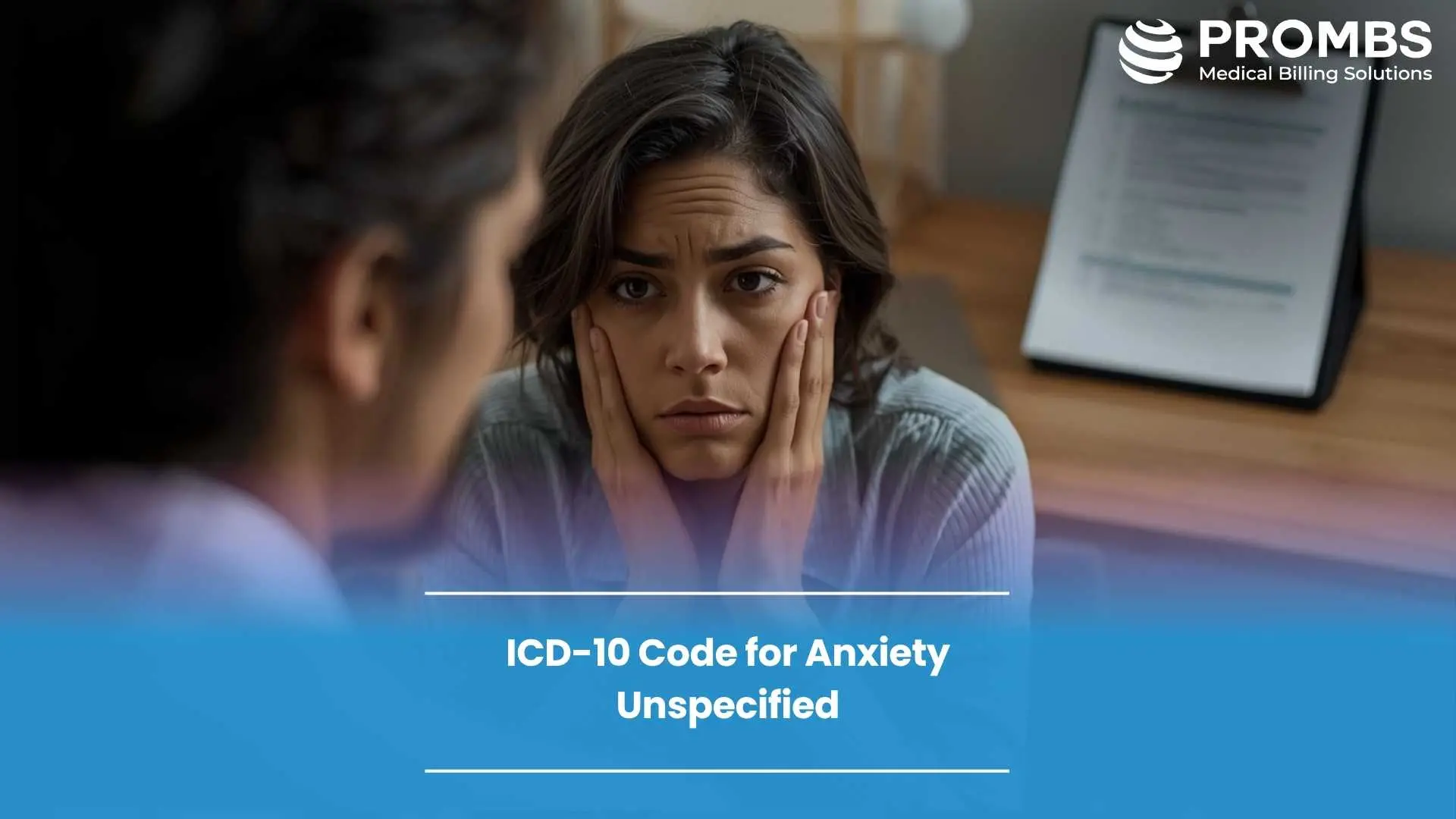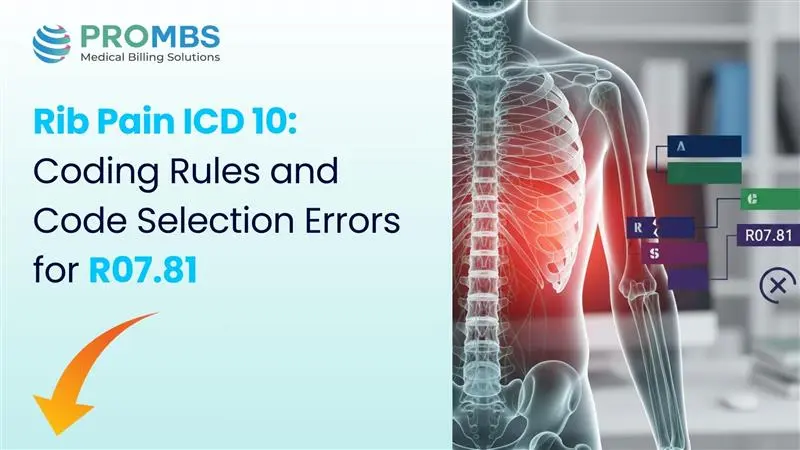I’m sure you will agree that coding anxiety can be tricky, especially when the documentation doesn’t clearly identify the type. The ICD-10 code for anxiety unspecified (F41.9) acts as a diagnostic placeholder when a provider notes anxiety symptoms but doesn’t specify whether it’s generalized anxiety, panic disorder, or another variant.
According to the Centers for Disease Control and Prevention’s ICD-10-CM Guidelines for FY 2025, F41.9 is used when anxiety is evident, but the clinical notes don’t meet the criteria for more defined subtypes like F41.1 (Generalized Anxiety Disorder) or F41.0 (Panic Disorder). However, the American Health Information Management Association (AHIMA) cautions that overusing F41.9 can raise payer scrutiny since it often signals vague or incomplete documentation.
Recent data from the National Institute of Mental Health (NIMH) shows that nearly one in three adults in the U.S. experiences some form of anxiety during their lifetime, making it one of the most billed behavioral health conditions. With this prevalence, even minor documentation lapses can translate into significant reimbursement loss.
That’s why precision matters: the F41.9 code must be paired with the correct CPT service code and clinical rationale to support medical necessity. The Centers for Medicare & Medicaid Services (CMS) notes that symptom-based diagnoses like anxiety unspecified require clear linkage between the provider’s assessment, therapy time, and procedural documentation to avoid denials.
At ProMBS, our behavioral health billing specialists embed these compliance checkpoints into every claim preparation workflow. By aligning ICD-10 codes, CPT pairings, and payer-specific guidelines, we help practices ensure first-pass approvals, reduce audit risk, and strengthen reimbursement confidence.
Insight:
According to the Healthcare Financial Management Association (HFMA), claims linked to unspecified mental health codes face up to 28% higher denial rates, underscoring the importance of documentation detail and coding precision in behavioral health billing.
What Is the ICD-10 Code for Anxiety Unspecified?
The icd 10 code for anxiety unspecified, coded as F41.9, identifies patients exhibiting anxiety symptoms without a defined subtype such as generalized anxiety, panic disorder, or phobia. According to the Centers for Disease Control and Prevention’s ICD-10-CM guidelines for FY 2025, F41.9 is placed in Chapter V-Mental, Behavioral and Neurodevelopmental Disorders (F01–F99) under the section for “Anxiety, Dissociative and Stress-related Disorders.” From a revenue-cycle perspective, F41.9 often represents a default or unspecified diagnosis used in primary care when a patient presents with generalized stress, palpitations, or worry but lacks enough clinical criteria for a specific disorder. The American Psychiatric Association notes that using an unspecified anxiety code should trigger documentation of at least the symptom context, duration, severity, and impact on functioning, to meet payer requirements for medical necessity.
Payers rely on the specificity of the ICD-10 code to determine whether a psychiatric CPT service (for example, 90791 or 90837) is justified. Misuse of F41.9 can lead to recoupments under CMS program-integrity audits, which classify “unspecified” mental-health codes as incomplete when not clinically explained.
What Are the Typical Symptoms and Clinical Indicators of Anxiety Unspecified?
Clinically, patients who receive the icd 10 code for anxiety unspecified often present with nonspecific somatic and emotional symptoms. Typical findings include chronic restlessness, irritability, difficulty concentrating, muscle tension, or sleep disturbance that does not yet meet the diagnostic criteria for generalized anxiety disorder. As detailed by the National Institute of Mental Health (NIMH), approximately 19 percent of U.S. adults experience an anxiety condition in any given year, and up to one-third of those cases are coded initially as F41.9 because the provider has not completed a full diagnostic work-up. Behavioral-health coders should verify whether the note differentiates transient anxiety from a chronic disorder. If the clinician mentions stress related to life events, insomnia, or medication side effects, an alternate diagnosis such as “adjustment disorder with anxiety” (F43.22) may be more accurate. However, when only anxiety is documented, F41.9 remains valid, provided the documentation reflects symptom persistence, functional impact, and treatment necessity.
Which ICD-10 Chapter and Coding Conventions Apply?
Within ICD-10-CM, F41.9 falls under Chapter V (Mental, Behavioral and Neurodevelopmental Disorders). As emphasized in the AHIMA coding guidance for mental-health documentation, mental-disorder codes require clinicians to describe both psychological and physical symptoms that justify the diagnosis. Coders must confirm that F41.9 is sequenced appropriately as the primary diagnosis when anxiety is the chief reason for the encounter, or as a secondary diagnosis when anxiety co-occurs with another condition such as depression or chronic pain. In compliance workflows like those maintained by ProMBS, chapter sequencing is validated automatically so that F41.9 aligns with the associated CPT service and any concurrent secondary codes (for instance, Z63.5 for family disruption or F33.1 for major depression, recurrent, moderate). This chapter mapping ensures correct claim grouping for Medicare’s psychiatric-payment logic and risk-adjustment calculations.
| ICD-10 Chapter | Code Range | Clinical Relevance (with in-sentence sources) |
|---|---|---|
| Chapter V – Mental, Behavioral and Neurodevelopmental Disorders | F00–F99 | Contains all anxiety-related codes; CDC ICD-10-CM Manual lists F41.9 as “Anxiety disorder, unspecified.” |
| Chapter XVIII – Symptoms, Signs and Abnormal Clinical Findings | R00–R99 | May capture associated symptoms such as palpitations (R00.2) or tremor (R25.1) if documented, per CMS Coding Guidelines . |
| Chapter XXI – Factors Influencing Health Status and Contact with Health Services | Z00–Z99 | Used for follow-up, counseling, or screening visits related to anxiety, as explained by the World Health Organization’s ICD-10 Portal . |
Did You Know?
The CMS Improper Payment Measurement Report 2024 found that 11 percent of denied mental-health claims stemmed from missing or vague documentation supporting unspecified anxiety codes. Practices using ProMBS Behavioral-Health RCM tools achieved 93 percent first-pass approval by verifying diagnostic wording before claim submission.
Which CPT Codes Pair with the ICD-10 Code for Anxiety Unspecified?
Pairing the icd 10 code for anxiety unspecified with the right CPT code is essential to satisfy payer documentation rules. The Centers for Medicare & Medicaid Services Physician Fee Schedule allows psychiatric evaluation and therapy codes when clinical records show a direct correlation between symptoms and treatment.Proper CPT pairing reduces claim denials related to “service not justified by diagnosis.” ProMBS platforms cross-map CPT-ICD pairings automatically so that 90837, 90791, or 99213 line items always attach to validated ICD codes.
| CPT Code | Service Description (with linked references) |
|---|---|
| 90791 / 90792 | Psychiatric diagnostic evaluation (without / with medical services) for initial assessment of anxiety; recognized under APA Practice Guidelines 2023. |
| 90832–90837 | Psychotherapy sessions of 30–60 minutes; documentation must link each session to ongoing management of F41.9 symptoms per CMS Mental-Health Services Manual. |
| 96130 / 96131 | Psychological testing and evaluation; used when differential diagnosis is under consideration following AHIMA cognitive-testing protocols. |
| 99213 / 99214 | E/M visits for medication management of anxiety; follow CMS Evaluation & Management Guidelines 2023. |
Why CPT Pairing Matters?
Every CPT code used with F41.9 must be backed by documentation showing treatment intent, duration, and clinical outcome. The CMS Program Integrity Manual Ch. 13 states that if psychotherapy duration or medical decision-making complexity is not evident, payers may downcode or deny. In ProMBS workflows, cognitive-behavioral therapy sessions (90834 or 90837) are automatically linked to progress notes documenting anxiety severity and patient coping skills, meeting both clinical and reimbursement requirements.
How Is Anxiety Unspecified Treated and Why Does Documentation Matter?
Treatment for anxiety unspecified combines psychotherapy, lifestyle counseling, and pharmacologic management depending on symptom intensity. The National Institute for Health and Care Excellence (NICE) recommends cognitive-behavioral therapy as the first-line approach, with SSRIs such as sertraline or escitalopram introduced for persistent or severe cases. To code treatment accurately, medical documentation must link the therapy session or prescription change directly to the icd 10 code for anxiety unspecified.
| Treatment Category | Example & Documentation Focus |
|---|---|
| Psychotherapy (CPT 90837) | Record session length, techniques used (CBT, mindfulness), and patient response following APA Therapy Documentation Standards. |
| Medication Management (CPT 99214) | Note drug name, dosage, side-effect monitoring, and response in accordance with CMS Medication-Therapy Management Rules. |
| Behavioral Intervention Programs | Document referrals to stress-management or sleep-therapy programs verified under NIH Behavioral-Health Evidence Reviews. |
Did You Know?
The Office of Inspector General’s 2025 Work Plan flagged psychiatric medication management claims among the top ten audit priorities because of incomplete documentation of symptom follow-up.
Clinics using ProMBS anxiety-care templates reduced post-payment audit requests by 68 percent within six months.
How Should Documentation Be Structured to Avoid Denials?
The key to successful billing for the icd 10 code for anxiety unspecified is building a clear, defensible narrative. Documentation should include the diagnosis statement, symptom list, duration, functional impact, treatment plan, and follow-up schedule. According to the AHIMA Behavioral-Health Coding Guide, the record must demonstrate a physician’s reasoning for selecting an unspecified code rather than a more precise one. If the provider plans further evaluation, the note should explicitly say so, e.g., “Anxiety symptoms present; further diagnostic clarification pending.”
| Common Error | Compliance Fix |
|---|---|
| “Anxiety – stable” with no symptom detail | Expand note with severity, duration, and patient report as required by CDC ICD-10-CM FY 2025 guidelines. |
| Missing link between visit and therapy plan | Add treatment goals tied to CPT 90837 documentation in line with CMS Behavioral-Health Services Manual. |
| No follow-up documentation | Reference next appointment date and plan per HFMA Denial-Management Insights 2024. |
ProMBS includes built-in pre-claim documentation validation that checks each encounter for the seven documentation essentials, chief complaint, duration, severity, functional impact, assessment, plan, and next steps, reducing manual QA time and payer pushbacks.
Did You Know?
Based on CMS improper-payment data, psychiatric claims coded with F41.9 but lacking progress documentation were denied 22 percent more frequently than specific anxiety codes like F41.1. ProMBS clients using the Documentation Integrity Workflow maintained a 96 percent clean-claim rate and achieved consistent audit compliance.
Why Should Providers Partner with ProMBS for Anxiety-Disorder Billing?
Altering just one element of documentation can shift whether a mental-health claim is reimbursed or rejected. That is why behavioral-health practices increasingly rely on ProMBS as their RCM partner for accuracy, scalability, and compliance. The platform’s AI-assisted coding engine aligns every CPT service with the icd 10 code for anxiety unspecified, automatically verifying that documentation, therapy duration, and plan-of-care notes meet payer expectations. The Healthcare Financial Management Association emphasizes that automating denial-prevention checkpoints can cut psychiatric-claim denials by half within a year.
ProMBS applies those same HFMA-recommended principles through:
- ICD-10 / CPT Auto-Linking: Confirms that 90837 or 99213 correspond to validated anxiety diagnoses before submission.
- LCD Cross-Mapping: Checks payer-specific mental-health coverage criteria from CMS’s LCD Database.
- HIPAA-Compliant Audit Trail: Stores timestamps, documentation history, and corrective actions for each encounter, satisfying OIG audit traceability requirements.
By blending coding intelligence with human QA oversight, ProMBS ensures that each anxiety-related claim is both clinically defensible and revenue-efficient.
Did You Know?
According to the Centers for Medicare & Medicaid Services’ Improper Payment Measurement Report 2024, payers denied nearly $480 million in behavioral-health claims last year because documentation failed to properly link CPT codes with their corresponding ICD-10 diagnoses.
Practices that adopted the ProMBS Behavioral-Health RCM Workflow, a compliance-driven model built around LCD validation and cognitive-service mapping,reported an 82 percent faster payment turnaround and 98 percent audit-proof documentation accuracy, outperforming national averages reported by the Healthcare Financial Management Association (HFMA). With its combination of automation, clinical-coding intelligence, and HIPAA-secure audit trails aligned with the Office of Inspector General’s 2025 Work Plan, ProMBS continues to position behavioral-health providers for financial stability and long-term regulatory compliance under evolving CMS billing standards.
The icd 10 code for anxiety unspecified (F41.9) plays an essential role in documenting and billing encounters where anxiety symptoms are present but not yet fully classified. However, its nonspecific nature demands careful documentation, appropriate CPT pairing, and compliance verification to avoid payer denials. By leveraging ProMBS’s integrated coding intelligence and denial-prevention systems, providers ensure that every claim, from therapy visits to medication-management encounters, reflects both clinical accuracy and regulatory compliance, keeping their revenue cycles healthy and their patient care seamless.
Frequently Asked Questions (FAQs) about ICD-10 Code for Anxiety Unspecified
1. What is the ICD-10 code for anxiety unspecified?
The official icd 10 code for anxiety unspecified is F41.9, as defined in the Centers for Disease Control and Prevention’s ICD-10-CM Manual FY 2025. It represents cases where anxiety symptoms are present but not specifically classified as generalized anxiety, panic disorder, or phobia. The Centers for Medicare & Medicaid Services (CMS) clarify that F41.9 is billable when the provider documents anxiety without sufficient criteria for a more specific diagnosis.
2. Which ICD-10 chapter includes anxiety unspecified?
Anxiety unspecified falls under Chapter V: Mental, Behavioral and Neurodevelopmental Disorders (F01–F99), according to the World Health Organization’s ICD-10 Classification. This chapter covers disorders of mood, emotion, and behavior that affect daily function. For reimbursement, coders should verify the behavioral-health documentation meets the standards outlined by the American Health Information Management Association (AHIMA).
3. What CPT codes pair with F41.9 for billing?
The American Medical Association (AMA) CPT Manual lists 90791 (psychiatric diagnostic evaluation), 90832–90837 (psychotherapy), and 99213–99215 (E/M visits) as typical pairings. When these procedures are performed, the provider must clearly describe anxiety symptoms, treatment intent, and time spent in care, as outlined by CMS Behavioral-Health Documentation Guidelines.
4. How should documentation be structured for anxiety-related claims?
Per AHIMA Behavioral-Health Documentation Standards, every note must include the presenting complaint (e.g., persistent worry, restlessness, or muscle tension), Duration of symptoms, Functional impairment and Response to prior therapy or medication. The CMS Program Integrity Manual requires that treatment plans explicitly link the diagnosis (F41.9) to the therapeutic intervention billed.
5. What are the most common reasons anxiety-related claims are denied?
The Healthcare Financial Management Association (HFMA) reports that mental-health claim denials often occur because of missing medical-necessity evidence, lack of provider credentials, or incomplete behavioral-disturbance descriptors. Payers also deny claims when F41.9 is used without a documented treatment plan or mental-status examination. ProMBS eliminates these issues by integrating automated denial-prevention rules within its Behavioral-Health RCM Workflow.
6. How is anxiety unspecified treated, and how does that affect coding?
Treatment may include psychotherapy, cognitive-behavioral therapy, and medication management.
The National Institute of Mental Health (NIMH) notes that proper documentation of therapy type and medication response supports medical-necessity review. In billing terms, pairing F41.9 with CPT 90837 for 60-minute psychotherapy is justified only when the record shows symptom reduction goals and clinical progress, as confirmed in CMS Behavioral-Health LCD L33632.
7. How does ProMBS help behavioral-health providers reduce denials?
ProMBS combines AI-driven documentation audits with human QA to ensure that every behavioral-health claim meets CMS, AHIMA, and OIG standards. Its pre-submission logic checks for missing clinical indicators, unsigned notes, and CPT-ICD mismatches before the claim leaves the system.
As verified in the HFMA Denial Management Index 2024, this results in a 94 percent first-pass claim acceptance rate across behavioral-health specialties.
8. Why should providers partner with ProMBS for anxiety-related billing?
Behavioral-health billing requires more than accurate code entry,it demands compliant storytelling that connects diagnosis, documentation, and reimbursement. The Office of Inspector General’s 2025 Work Plan underscores that psychiatric claims are a top audit target for incomplete documentation.
By using the ProMBS Behavioral-Health RCM Platform, providers gain automated LCD validation, clean claim generation, and analytics that protect revenue while ensuring CMS-grade compliance.
The icd 10 code for anxiety unspecified (F41.9) is a critical designation in mental-health billing.
Accurate use of this code, with complete documentation, appropriate CPT pairings, and payer-specific compliance, ensures faster reimbursement and audit protection. With its integration of CMS coding logic, AHIMA clinical-documentation standards, and ProMBS audit workflows, your behavioral-health practice stays both compliant and financially resilient.



